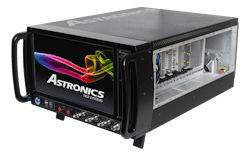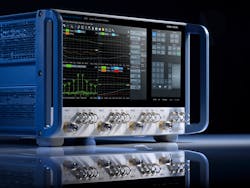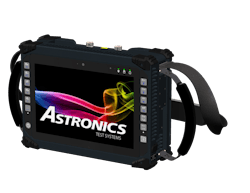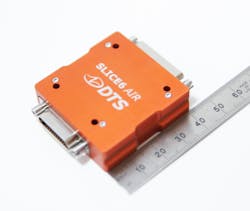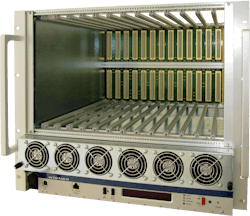Download this article in .PDF format.
From Aug. 26-29, the Gaylord National Convention Center in National Harbor, MD will welcome IEEE AUTOTESTCON 2019, bringing together the military/aerospace automatic test industry, government/military acquirers and users to share new technologies, discuss innovative applications, and exhibit products and services. There are plenty of other industry events throughout the year that highlight solutions and applications within Mil/Aero test, but AUTOTESTCON hits it right on the head. Besides hosting 50+ exhibitors, the conference offers plentiful education opportunities for anyone in the industry to get the latest on technology developments in Mil/Aero test.
The event was originally scheduled for September, but a large increase in attendance and exhibitors since AUTOTESTCON was booked resulted in a need for additional exhibiting and meeting space, and thus a date change.
Timing with AUTOTESTCON, we at Evaluation Engineering sought to provide our readers with an in-depth report on the topic of Mil/Aero test, asking vendors for their thoughts on trends in technology and the general market, innovation challenges they’re facing, customer demands, and what new Mil/Aero solutions they’ve recently put on the market. Read on to learn what they told us.
What’s trending?
What technology or market trends are vendors seeing in the area of Mil/Aero test?“The use of a common software development environment and test executive, which can be leveraged to cover the functional requirements from the flightline to depot, is also gaining traction. A common software development environment can maximize the utilization of resources and training.”
Paolo Colombo, global industry director for aerospace and defense at ANSYS: “The aerospace and defense (A&D) industry is at a pivotal crossroads, with an exponential number of new technologies and applications like additive manufacturing, advanced electronics, hypersonics, and digital twins changing the way we design, test, sustain, and operate aircraft and weapon systems. This presents a challenge because younger technologies require extensive (and expensive) testing and validation before adoption, yet the pace of innovation is so fast that a technology could become obsolete before it reaches the market. Maintaining technology superiority is paramount today and slowing down new technology adoption is simply impossible. This requires a holistic view of the product’s entire lifecycle and digitalization.”
Applications engineers at Amplifier Research: “While test standards are always slow to change, there does seem to be a trend—even if unintentional—to better harmonize MIL/Aero standards. For example, the latest version of MIL-STD-461 (G) has incorporated indirect lightening testing (CS117) from DO-160G, as well as ESD testing (CS118). Both standards continue to evolve and take new and emerging technologies and threats into account.”
Bob Stasonis, technical product specialist at Pickering Interfaces: “Today’s Mil/Aero market testing requirements very closely track the commercial industries in terms of increased bandwidth, complexity, and intelligence. Whereas the commercial industry is always abandoning old technology for the “next big thing,” the problem—or rather, balancing act—with Mil/Aero test systems is always to have the most up-to-date test system that ALSO supports older defense programs. That increase also emphasizes the need for hardware-in-the-loop simulation (HILS) testing. A weapons system needs to continue to function as predictably as possible when damaged by enemy fire. So, testing LRUs to see how they react in a bad situation calls for HILS applications.”
Darren McCarthy, A&D technical marketing manager at Rohde & Schwarz: “A major challenge for Mil-ATE customers is staying vigilant to the latest threats on instrument security. Modern test equipment utilizes the latest computing processing power available and often runs on embedded versions of industry-standard operating systems such as Windows, iOS, and Linux. With modern connectivity of LAN, USB, and even Wi-Fi control in some cases, operating procedures must be maintained to reduce the vulnerability to cyberattacks and an environment free from malicious threats.”
Glenn Woppman, CEO of ASSET InterTech: “In terms of ATE testers, continuing to try to standardize and use more commercially available solutions like eCASS tester-leveraging solutions from LM-Star testers.”
Nick Butler, head of global aerospace & defense marketing at National Instruments: “On the aerospace side, the “race to space” is heating up with more and more countries planning manned missions to the moon and private entities looking at everything from public space travel to a better way to provide launch services for small satellites. The proposed DoD budget for 2020 even includes funding for a new military branch called U.S. Space Force, which will undertake missions and operations in the rapidly-evolving space domain. These developments will be an incredible undertaking for test engineers in the coming months and years as rapid development times will create increased pressure on the test and measurement cycle.”
Huy Nguyen, aerospace & defense sales manager at Diversified Technical Systems (DTS): "Customers are adding more sensors channels to tests, but they still need instrumentation to be ultra-low size, weight, and power (SWaP) optimized. Especially for applications like aircraft store, missiles, and unmanned aerial systems—to meet the size and mass restrictions—customers need data acquisition units that can be embedded on or in the test articles."
WIENER Power Electronics GmbH: "Old standards like VXI are still in high demand and need support for many years to come. Many MIL programs rely on these old technologies. New bus technologies like PXIe face challenges in high density, power, and cooling."
Challenges
What key challenges are vendors or their partners facing in Mil/Aero test?Vondran, Astronics: “Using tactical radios as an example, support for secure modulation waveforms impose higher performance prerequisites on the requisite test architecture. To complicate matters, tactical radios also trend for more test data to identify outliers and/or latent defects. The trickle-down effect to field test is higher performance instrumentation with greater spectral purity, more precise amplitude/phase readouts, faster automated measurements, and provisions to simulate more crowded spectrums for interference issues. There are additional practical test issues to consider in the field as it pertains to cables, connectors, antennas, and other sources of environmental contamination. Quickly finding and repairing defect mechanisms is becoming more complex and time-consuming—not just in the depot—but also field (ideally using the same automation software). With that said, providing portable, easy-to-use, and rugged tools across various user scenarios also represents a key challenge to ensuring secure communications.”
Colombo, ANSYS: “There are many challenges. One is integration, as we are moving from a siloed view of the assets’ lifecycle to a more integrated one. Digital and physical testing will complement each other much more, both concurring to assets’ validation and certification. It’s important to understand and embrace this revolution because it offers huge growth opportunities for those who will be able to operate in partnership.”
Butler, National Instruments: “Digital transformation—the need to acquire, process, store and analyze extremely large amounts of data to extract insights that will improve operational efficiency, as well as the need to connect and remotely manage dozens—to potentially thousands—of test assets and systems across the enterprise. This introduces challenges in terms of security, process management, and cross functional collaboration.”
Barnard, Tektronix: “All Mil/Aero test vendors face the challenge of presenting next-generation testing capabilities— higher bandwidths, sharper software, more advanced triggers, etc.—to Mil/Aero customers in a product architecture that is going to be available for program support over a long period of time; sometimes as much as a decade or more.”
Eijkelenburg, Pacific Power Source: “One of the biggest challenges our Mil/Aero customers face is the need to support existing test platforms much longer than originally planned. Test platforms are not being replaced in a timely matter, due to budget constraints. This is shifting increased focus from developing new test systems to upgrading and supporting existing aging testers. As a result, T&M equipment manufacturers are asked to support their products for long periods of time—far longer than would be the case for industrial or commercial use test systems.”
Stasonis, Pickering: “Many Mil/Aero test systems need to migrate from existing obsolete VXI-based test systems to modern, well-supported platforms such as PXI and LXI. We have a cross reference chart on our web site that offers PXI-based replacements for the popular VXI switch modules of the 1990s and early 2000s. Security is an important issue for Mil/Aero Applications. As our modules carry minimal memory and rely on the system PC to do the “heavy lifting,” it is relatively simple to clear the memory, ensuring that no sensitive information can be carried out of the test environment.”
Woppman, ASSET InterTech: “Unknown potential risk due to industry consolidation and its impact. With Raytheon and UTC, plus L-3 and Harris, and potentially others, it is not certain what risks might be posed for the test vendors.”
- USB mass memory write protection option
- Security write protection for solid-state drives options
- Removable hard drives
- Instrument security and erasure procedures
- Write protection utility installation procedures for each operating system
- A letter of volatility”
Nyugen, DTS: "Flight test engineers are very concerned with size, mass, and synchronization, but they are also interested in ways they can reduce test set up time. A single test can take days, weeks, or months to prepare. So the idea of rapid deployment data acquisition units they can add last-minute to support test modifications like additional sensor channels or new points of interest is a game-changer."
WIENER Power Electronics: "We face difficulties on the component market as for instance obsolete items and very long lead times."What are customers asking for?
What features or innovations are customers asking for in Mil/Aero test?Sargeant, Marvin Test Solutions: “Customers are often seeking innovative test solutions that can quickly and accurately diagnose problems with increasingly complex and sophisticated aircraft armament and munitions. In addition, many of these same customers face major obsolescence issues, as they are being asked to extend the service life of existing aircraft with advanced armament and weapons—placing further demands on maintainers forced to use outmoded and obsolete test sets. MTS’ focus is on delivering solutions enabling common maintenance test equipment that can support multiple aircraft across all maintenance levels, thus streamlining logistics and training.”
Vondran, Astronics: “In depot settings, the automation of electrical test simplifies maintenance activities and enables maximum up-time of the tested platform. As defect mechanisms become more complex, the test solutions must evolve to maintain ease-of-use while reliably finding faults. Depot test needs suppliers to ruggedize, automate, and optimize solutions to last longer, which is fueling the shift to modular instrumentation. Depot test or backshop testing of field return devices frequently reveals no fault found (NFF) or cannot duplicate (CND) results (i.e., the radio is working properly). In this case, the root cause of the original fault lies elsewhere in the field. Moving a more resilient analysis closer to the original diagnostic can minimize the NFF/CND problem. A truly portable solution is necessary to simplify maintenance activities to find the root cause.”
Amplifier Research: “Customers continue to ask for full turnkey systems and full automation of said systems. While it is difficult to automate some of the tests required per Mil/Aero standards, it is a challenge that test equipment manufacturers have to overcome. To better suit the market, equipment manufacturers and integrators are finding new ways to better integrate equipment into more easy-to-use packages.”
- Multichannel, phase-coherent RF measurements in frequency bands up to 40+GHz
- The ability to stream large amounts of data across a bus, backplane, or even over-the-air
- The capability to perform real time, deterministic, inline signal processing on multiple channels in parallel
- The ability to create or simulate dozens to potentially thousands of multi-emitter scenarios to test and validate RADAR or EW system performance
- High dynamic range to detect both large and small signals within a single system
- High instantaneous bandwidth to be able to monitor, process, and/or create signals across a wide spectrum of frequencies simultaneously”
Colombo, ANSYS: “From our point of view, customers want to speed up the technology insertion and certification systems, which grow in complexity year-after-year. Take the F-35, for example. It has 177 times more software on board than the F-16, with a development effort estimated to be 298 times greater. This software is supervising critical activities, so it must be verified and tested in every possible situation. The next generation of aircraft will be even more complex: testing can only be digital. Another important request involves evaluating COTS parts to ensure they can be used in a warfare environment with confidence.”
Eijkelenburg, Pacific Power Source: “Customers are asking for more flexible programmable power solutions that not only support higher power levels found in newer airframes, but also higher voltage ranges and the ability to test both AC and DC power systems.”
Stasonis, Pickering: “Diagnostics—As switching is primarily a mechanical environment, it is possible that a switching system can be damaged by events such as a mistake when generating the test code or the testing of a defective DUT. To facilitate the timely field repair of a damaged switch module, Pickering offers BIRST (Built-In Relay Self-Test) at no extra cost on many of our high-density switching matrices.”
McCarthy, Rohde & Schwarz: “Support for beamforming and antenna array measurements from the IC test, to the T/R module, and even including over-the-air testing. Fielding new technologies such as the multifunction radar or phased-array LEO tracking antennas is one of the biggest challenges facing the aerospace and defense industry.”
Barnard, Tektronix: “1) Ruggedized, portable systems for field and range testing applications. Increased channel counts and frequency are of related importance to many range-focused Mil/Aero customers. 2) Recording capabilities that enable extended logging of real-time RF I & Q data at high bandwidths. 3) Advanced triggers that allow real-time spectrum analyzers to detect spurious, intermittent, or anomalous signals that swept-tuned instruments will miss.”
Nguyen, DTS: "DAQ and sensors that can fit onboard test articles without altering test dynamics—so that means small, modular, low mass, and low power. It’s also critical that the systems are rugged to withstand the extreme test environments including altitude, temperature, shock, and vibration. By the time that customers get to DTS, they have already made big investments in time, money, engineering and simulation testing to get a test article to prove out in real life. DTS miniature data acquisition units let customers validate real-time and in-situ."
Woppman, ASSET InterTech: “We are beginning to see adoption of fast in-system programming solutions as memory size increases.”
Now on the market
Here are the Mil/Aero test solutions that vendors told us they’ve recently made available.Amplifier Research: “AR has developed the AA series of field generating products for producing high-frequency, low-level electric fields. For traditional test configurations, today’s current market requires expensive solid-state or TWT amplifiers to generate field strengths of 20-50 V/m from 18-40 GHz. These are the same amps that are used for generating 200 V/m. Rather than requiring customers to pay for power they don’t need, the AA series products are a fraction of the cost of traditional amp/antenna solutions, while offering greater reliability than TWT amplifiers.”
Colombo, ANSYS: “ANSYS recently acquired DfR Solutions, an engineering consultant that owned Sherlock, the industry’s only automated design reliability analysis software. Currently, electronics reliability analysis is often skipped or performed late in the product design process. Our Sherlock Automated Design Analysis software offers a unique, fully validated, turnkey solution for analyzing the physics of failure for a wide variety of electronics systems and components. Using independently validated algorithms, engineers can subject their products to virtual constant temperature, thermal cycling, power-temperature cycling, thermal shock, random vibration, harmonic vibration, mechanical shock, and flexure to help ensure manufacturability and maximize product lifespan.”
Kikusui: “We recently launched PCR-WE/WE2, which is a new series of multifunctional switching AC power supplies that combines accurate, high power output and ultra-compact design. The 15 model lineup ranges from 1 kVA to 36 kVA AC/DC with single- & three-phase variable output from 6 kVA and up. The PCR-WE/WE2 also features a regenerative mode that can drastically reduce power consumption and cut the costs of operation. The PCR-WE/WE2 also supports mix-and-match parallel operation up to 144 kVA for large-scale test systems. Output frequency up to 5 kHz is also available with all models for critical AC applications in the avionic industries.”
Eijkelenburg, Pacific Power Source: “Our new AFX Series of AC and DC power sources fits the need for more flexible, capable and higher power programmable test solutions. With a power density of 15kW in only 4U (7 inch) or ATE rack space, the AFX Series is unchallenged on price, performance, and power density in the industry. A modular architecture supports power systems ranging from as little as 6kVA to as much as 180kVA, all using the same redundant units. This provides incredible flexibility to the end user.”
Woppman, ASSET InterTech: “Recently, we launched the ScanWorks PFx product line that supports SoCs with at-speed testing, fast device programming, and memory-tuning validation. This adds more value, in terms of increasing test coverage complementing boundary-scan test shorts/opens testing. Initial SoC support is for the Xilinx Zynq and NXP i.MX families that are being designed into new defense projects.”
Butler, National Instruments: “NI recently launched a vector signal transceiver extending the frequency range up to 40GHz. With an on-board FPGA and VNA/generation capabilities, this product opens-up several new frontiers for NI. What differentiates this product is its capability to make real-time measurements on wideband signals and run complex models on its FPGAs to simulate real-worldNguyen, DTS: "The new SLICE6 AIR data acquisition unit from DTS is just launching now. It’s designed specifically for aerospace and defense testing. Like all DTS systems, it’s rugged, super small, and it stores all the data to onboard flash memory. But SLICE6 AIR also does real-time streaming in IRIG Chapter 10 or TmNS, it has universal sensor support and it supports several synchronization options including IEEE 1588 PTPV2."
Applications
What novel or unique applications have these vendors’ Mil/Aero test solutions been used for recently?Sargeant, Marvin Test Solutions: “Designed for rugged flightline, field, and backshop maintenance test use, the MTS-207 is a state-of-the-art portable ultra-rugged PXI platform ideally suited for use in the harshest environmental conditions. Its proven, MIL-SPEC qualified architecture is deployed worldwide on the MTS-206 Maverick Missile and Launcher Test Set, the MTS-209 Common Armament Test Set, the AN/TSM-205B Hellfire System Test Set, to name a few of the many applications. Most recently, the USAF selected the MTS-207 to support the PATS-70 and PATS-70A programs.”
Vondran, Astronics: “ATS is a strategic supplier of field solutions for tactical radio and wire integrity testing. Our value to the ecosystem lies in our ability to offer scripted test program sets (TPS) that provide not only generic health assessment, but also detailed failure mechanisms. Our standardized approach offers a universal tester for the inventory of many types of units under test. As an example, ATS offers the largest library of tactical radio TPSs that automates and standardizes field test.”
Amplifier Research: “Recently, AR delivered a turnkey system capable of testing radiated immunity to Tables 1-6 of MIL-STD-464C, full coverage up to 40 GHz. This includes peak field strengths of up to 4,400 V/m. All of the equipment, including signal generators, power meters, switch matrices, amplifiers, antennas, and antenna masts were mounted to rolling platforms in RF shielded racks and were capable not only of fully automated RF control, but also of height adjustments of up to 5 meters.”
Eijkelenburg, Pacific Power Source: “Our products are being used in the development and test of new electric subsystems that replace traditional hydraulic systems and are designed to recover energy where possible. Examples of such subsystems are landing gear, flaps and nose-wheel taxi traction motors.”
Barnard, Tektronix: “Mil/Aero test customers are using the Tektronix RSA518A for a broadening range-of-field solutions where the system’s small, rugged form factor and 18 GHz real-time spectrum analysis capabilities add value. Examples of these solutions include radiation hazard testing at airfields and onboard naval vessels; remote, networked spectrum monitoring nodes; and detection of commercial drones.”
McCarthy, Rohde & Schwarz: “The R&S ZNBT40 has been successfully integrated into a beamforming IC test system. The ZNBT enabled a manufacturer to reduce the size of the antenna feed network at mmWave frequencies. Reducing the size and cost of beamforming networks and antenna system is one of the critical technologies required for satellite LEO constellations, 5G NR technologies, and radar.”
Woppman, ASSET InterTech: “We are doing education and business development work in the area of No Fault Found, where last year’s Autotestcon keynote expressed the DoD is spending billions of dollars on this problem. Our solution to help impact and reduce that spend is ScanWorks Embedded Diagnostics. This is debug and test software that can be embedded into the end system to support improved diagnosability in-system.”
Nguyen, DTS: "DTS systems have been on SpaceX missions, the Orion space capsule, and the recent big drop test at NASA of the Fokker F-28 transport aircraft at the Landing and Impact Research Facility. It had over 600 channels, 24 crash test dummies, and dozens of cameras. Because the systems are so small, DTS data acquisition systems are also being used for rotor testing, as well as UAS/UAV development."
About the Author




